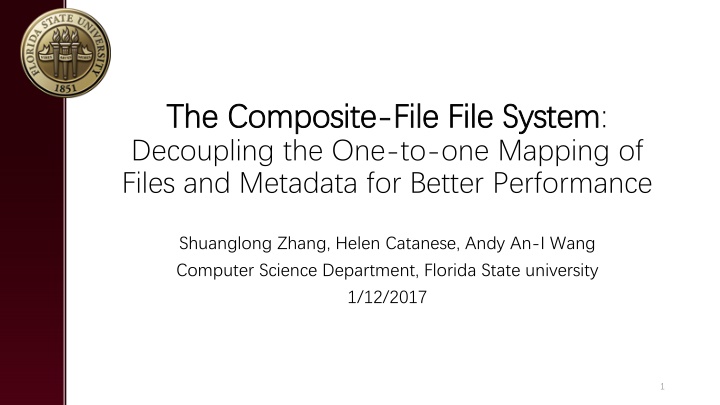
Decoupling Files and Metadata for Enhanced File System Performance
Enhance file system performance by decoupling the one-to-one mapping of files and metadata. Explore the benefits of using a Composite-File System (CFFS) to consolidate logical files into composite files, leading to a 27% performance gain. Learn about the Linux Storage Stack, Virtual File System (VFS), Ext4 file system, and more. Discover a new approach to file management for improved efficiency and access to data.
Download Presentation

Please find below an Image/Link to download the presentation.
The content on the website is provided AS IS for your information and personal use only. It may not be sold, licensed, or shared on other websites without obtaining consent from the author. If you encounter any issues during the download, it is possible that the publisher has removed the file from their server.
You are allowed to download the files provided on this website for personal or commercial use, subject to the condition that they are used lawfully. All files are the property of their respective owners.
The content on the website is provided AS IS for your information and personal use only. It may not be sold, licensed, or shared on other websites without obtaining consent from the author.
E N D
Presentation Transcript
The Composite The Composite- -File File System Decoupling the One-to-one Mapping of Files and Metadata for Better Performance File File System: Shuanglong Zhang, Helen Catanese, Andy An-I Wang Computer Science Department, Florida State university 1/12/2017 1
Background Background A file consists of two parts: metadata and data File Meta Meta data data Data Data To access the data of a file, its metadata needs to be accessed first Performance Conclusion Introduction Introduction Design Implementation 2
Linux Storage Stack Linux Storage Stack Applications VFS VFS ext4 FUSE FUSE Block Layer Block Layer Device Driver Device Driver Storage Device Storage Device 3
Background Background Virtual File System (VFS) provides a generalized, unique interface to application for file related operations. Read, write, open, close, Benefits Same interface for different file systems DVD, HDD, thumb drive (flash, also known as SSD) Dispatches operations to file-system-specific routines Performance Conclusion Introduction Introduction Design Implementation 4
Background Background Ext4 is the most commonly used local file system on Linux Derived from Ext3, with more advanced file system features such as extended attributes Performance is good on various workloads and different storage types (HDD, SSD) Performance Conclusion Introduction Introduction Design Implementation 5
Overview Overview Current state One-to-one mapping of a logical file and its physical metadata (i- node) and data representations Observations Files are accessed in groups Tend to be small and share similar metadata Composite-File File System (CFFS) Many logical files can be consolidated into a single composite file with its shared metadata and representation Up 27% performance gain composite file Performance Conclusion Introduction Introduction Design Implementation 6
Current State Current State Each logical file is mapped to its physical metadata and data representations Deep-rooted data structures Natural granularity for many file system mechanisms VFS API, prefetching, etc. Suppose we relax this constraint Can we create new optimization opportunities? Performance Conclusion Introduction Introduction Design Implementation 7
Observations Observations Frequent accesses to small files Metadata a major source of overhead for small files (~40% slowdown) Redundant metadata information (e.g., file owner) Potential opportunities to consolidate Files accessed in groups Why physically represent them separately? Limitation of prefetching High per-file access overhead even with warm cache Performance Conclusion Introduction Introduction Design Implementation 8
A Composite File A Composite File file 1 Subfile 2 Subfile 3 Subfile 1 i-node with consolidated metadata data blocks data blocks file 2 data blocks file 3 Performance Conclusion Introduction Design Design Implementation 9
Metadata Design Highlights Metadata Design Highlights Upper bits Lower bits 00 00 0 0 00 00 1 1 Modified i-node numbers If number > X (e.g., 011) Treats zero-extended upper bits as i-node numbers Treats lower bits as subfile numbers Directory representation Names are mapped to modified i-node numbers Subfile s metadata stored in extended attributes Permission: first check the permission of the composite file, then that of the target subfile 01 01 0 0 01 01 1 1 10 10 0 0 10 1 11 11 0 0 11 1 10
Subfile Subfile Operations Operations Open/close Open the composite file and seek to the offset of target subfile Close the entire composite file Add a subfile Append to the end Remove a subfile Mark it as freed Performance Conclusion Introduction Design Design Implementation 11
Subfile Subfile Operations (cont.) Operations (cont.) Read/write operation Read from the starting offset of the subfile, bounded by subfile size Write from the starting offset of the subfile, bounded by subfile size May move the entire subfile to the end if there is not enough space Space compaction When half of the space is marked as freed Performance Conclusion Introduction Design Design Implementation 12
Ways to Form Composite Files Ways to Form Composite Files Directory Directory- -based Groups all files in one directory Embedded Embedded- -reference reference- -based Groups files based on the extracted references (e.g., URLs) Frequency Frequency- -mining mining- -based based consolidation Based on variants of Apriori Algorithm Frequently encountered file request sequences must contain frequently encountered sub sequences based consolidation based consolidation Performance Conclusion Introduction Design Design Implementation 13
Directory Directory- -based based 14
Apriori Apriori Algorithm Algorithm Proposed in 1994, used to discover frequent item set Uses a bottom-up approach, generates candidate item sets of length k from item sets of length k-1 Threshold can be set to filter results Performance Conclusion Introduction Design Design Implementation 16
Apriori Apriori example example Per IP/PID Item Per IP/PID Item sets sets Item Item Support Support Input sequence Input sequence {1,2,3,4} {1} 3 1, 2, 3, 4, 1, 2, 4, 1, 2, 2, 3, 4, 2, 3, 3, 4, 2, 4, {1,2,4} Min_support Min_support: 3 : 3 {2} 6 {1,2} {2,3,4} {3} 4 {2,3} {4} 5 {3,4} {2,4} Performance Conclusion Introduction Design Design Implementation 17
Apriori Apriori example example Items Items Support Support Items Items Support Support {1,2} 3 {2,3,4} 2 {1,3} 1 {1,4} 2 {2,3} 3 {2,4} 4 {3,4} 3 Performance Conclusion Introduction Design Design Implementation 18
O Optimizations ptimizations Form only non-overlapping sets Use sliding window to reduce memory requirement Use normalized threshold (support), between 0 and 1 Create composite-file layout based on the order of sub-file references Performance Conclusion Introduction Design Design Implementation 19
Comparison of three ways Comparison of three ways Directory Directory- -based Tends to have good prediction accuracy and least processing overhead Embedded Embedded- -reference reference- -based based consolidation Tends to have the best prediction accuracy, needs to be aware of the content Frequency Frequency- -mining mining- -based based consolidation Tends to have better prediction accuracy than first approach, but comes with higher processing overhead based consolidation Performance Conclusion Introduction Design Design Implementation 20
Implementation Prototyped CFFS via FUSE+ext4 Intercepted file related system calls and performed the changes described in the design section Mapped multiple file names to the composite file i-node Used extended attributes to store consolidated metadata 21
FUSE FUSE File system in userspace (FUSE) is a framework that allows people to implement a file system in userspace Redirects the file related requests from VFS to the file system implementation in userspace Allows file system stacking Comes with performance overhead Performance Conclusion Introduction Introduction Design Implementation 22
FUSE FUSE 23
CFFS Components CFFS Components Introduction Design Implementation Implementation Performance Conclusion 24
System Configurations System Configurations Platform Processor: 2.8GHz Intel Xeon E5 Memory: 2GB * 4, 1067MHz Hard Disk: 250GB, 7200 RPM Flash Disk: 200GB, Intel SSD Performance Performance Conclusion Introduction Design Implementation 25
Workloads Workloads Web server trace 3-month long, 14 M references to 1TB of data (76GB unique) Create dummy file content Software development workstation 11-day long, 240M file-system-related system calls to 24GB of data (2.9GB unique) Local zero-think time replays Only replay open, close, read, write 26
Experimental Setups Experimental Setups FUSE+CFFS+ext4 vs. FUSE+ext4 Various composite-file approaches Performance Performance Conclusion Introduction Design Implementation 27
Web Web Server Latency Server Latency HDD HDD SSD SSD Performance Performance Conclusion Introduction Design Implementation 28
Software Development Trace Replays Software Development Trace Replays Performance Performance Conclusion Introduction Design Implementation 29
Discussion Discussion CFFS can benefit both read-mostly and read-write workloads using HDDs and SSDs Performance gains are mostly from reduction of metadata IOs (~20%) Performance gain from modified data layout is about 10% Directory and embedded-reference-based schemes incur an initial deployment cost Overhead for frequency-mining-based scheme is offset from the performance gain Performance Performance Conclusion Introduction Design Implementation 30
Conclusion Conclusion CFFS decouples the one-to-one mapping of files and metadata Increases throughput up to 27% Reduces latency up to 20% The CFFS approach is promising Performance Conclusion Conclusion Introduction Design Implementation 31

